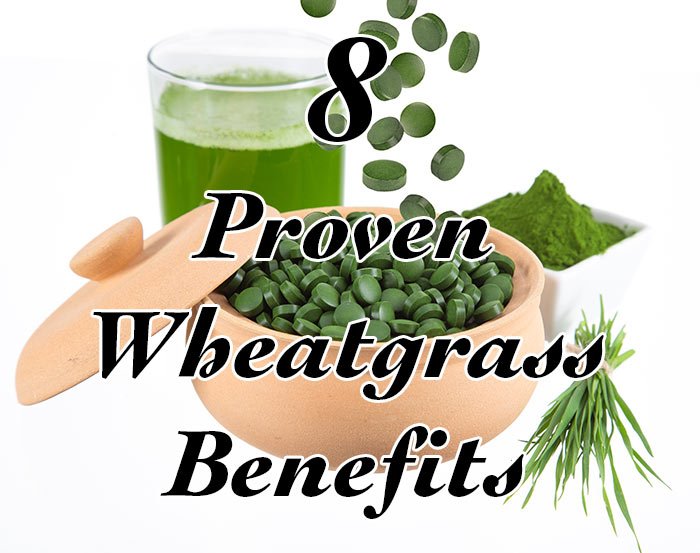Last Updated on October 31, 2016 by Marc Seward
Wheatgrass Benefits
Wheatgrass is an increasingly popular ingredient for the juice machine especially for those who are trying to increase their nutritional intake. While the majority of people actually juice wheatgrass, it is also available in supplementary forms like powders, pills and capsules.
There are plenty of websites that claim wheatgrass has a huge variety of health benefits but in truth, there is little scientific evidence to back up many of these lofty claims. It is also true that the potential benefits of wheatgrass depend largely on its quality and the way in which it is grown. Growing your own wheatgrass at home is easy enough and it is also both a cheaper option and the best way to ensure that you control quality.
Wheatgrass nutrition in a nutshell
While wheatgrass is often marketed as a nutritional powerhouse, many nutritionists argue that it has no more nutritional value than many other sprouts or commonly eaten vegetables. One common claim made by wheatgrass proponents is that a 30ml glass of wheatgrass juice contains the equivalent amount of nutrients as a kilogram of leafy green vegetables.
However tests do not agree. In fact, the nutritional value of wheatgrass is around the same as broccoli, spinach, sprouts and other common vegetables and that’s certainly not a bad thing.
Having said that, there is no doubt that wheatgrass is good for you and it contains a range of healthy nutrients including the following:
• It is a very rich source of Vitamins A and C and also contains most of the B vitamins.
• It has a very high chlorophyll content and chlorophyll is believed to have a range of health benefits.
• Wheatgrass contains a wide variety of important minerals including a high concentration of magnesium, potassium, sodium and calcium.
• It contains a number of essential enzymes like protease, lipase and cytochrome oxidase which all perform valuable bodily functions such as aiding protein digestion, splitting fats and protecting against oxidative stress.
• It contains numerous important amino acids including glycine, lysine, arginine, serine, leucine and tryptophan.
Wheatgrass Benefits
Most Health Benefits of Wheatgrass are related to its high chlorophyll content.
1. Increases red blood count
According to its proponents, wheatgrass is able to boost your body’s red blood count. This is because the chlorophyll in wheatgrass plays a similar role to hemoglobin in the human blood. The main difference being that the main element in chlorophyll is magnesium whereas for hemoglobin it’s iron.
Some experts have suggested that because of this similarity our bodies are able to transform chlorophyll easily into hemoglobin. This results in an increased red blood count and improved ability to transport oxygen and nutrients to the cells.
A study published in 2004 examined the efficacy of wheatgrass on thalassemia a blood disorder and found half the patients needed fewer transfusions after being treated with wheatgrass for 3 years. (1)
2. Eases inflammation of the colon
A relatively small scale study involving 21 patients published in 2002 found that patients suffering from ulcerative colitis or inflammation of their colon experienced an improvement in symptoms after being treated with a daily dose of 100 ml of wheatgrass juice for one month. (2)
3. It cleanses the body
Many people swear by the cleansing ability of wheatgrass juice and it is popularly used in many detox diet plans. Regularly detoxing your body is an excellent way to ensure that your body is clean of toxins and in the best possible shape going forward.
Wheatgrass is nutrient dense and considered to be an excellent option for cleansing the blood, the organs and the gastrointestinal tract.
Also because of its high saponin content, wheatgrass helps to support the lymphatic system which helps remove many unwanted toxins from the body’s cells.
4. Boosts immunity and fights illness
Wheatgrass is an excellent source of vitamins-in fact it is very high in vitamins C and E and also contains the majority of B vitamins as well as beta carotene. It contains 19 amino acids and as many as 90 different minerals. Many of these 90 minerals are alkalizing and contribute to an alkaline environment including calcium, magnesium, sodium and potassium.
Wheatgrass can protect us naturally from many illnesses because it has excellent anti-bacterial qualities. According to some experts, consuming wheatgrass can even protect the body against certain carcinogens.
5. Digestive complaints
Wheatgrass juice and powder may be able to improve digestion and ease a variety of complaints related to the digestive system and gastrointestinal tract. These conditions include ulcerative colitis, peptic ulcers, diarrhea and constipation.
6. Tooth decay
There is no science to back up the claim but according to proponents, wheatgrass can help your oral health in several ways. Adding wheatgrass juice o your diet can help keep your teeth and gums strong and protect against tooth decay.
You can also use wheatgrass juice to ease toothaches by holding the juice in your mouth for 5 minutes or so. I am not sure if it works, but it is certainly worth a try for those of us who suffer from the agony of toothache too often.
7. Antiseptic quality
Wheatgrass has antiseptic and antibacterial properties and can be used to treat minor wounds, burns, staph infections ear infections and scars.
8. Other purported benefits
I have only mentioned a few of the many potential benefits of wheatgrass above. There are many websites that list a whole host of benefits including a very long list published by The Hippocrates Health Institute. While the list is long, supporting evidence is lacking but the list includes the following:
– Restores fertility
– Helps regulate blood sugar levels
– Good for skin conditions including psoriasis and eczema.
– Can ease a sore throat
– Improves eyesight
– Aids sleep
– Improves emotional well-being
– Prevents hair from graying
– Improves joint pain and arthritis
Available forms of Wheatgrass
Wheatgrass is available in both fresh and powdered form. It is easy enough to grow your own wheatgrass a home but if you don’t have access to fresh wheatgrass, powdered supplements are readily available.
Possible Wheatgrass Side Effects
Wheatgrass is generally considered to be safe but there are certain possible side effects that you should be aware of.
• Nausea and Headaches
As we have already mentioned, wheatgrass contains very high amounts of chlorophyll which helps the detoxification process. Sometimes however, this process of removing toxins from the body can result in nausea especially when you are taking it for the first time.
As more toxins are released from the body, the nausea will eventually subside. The nausea caused by the detox process is often accompanied by headaches and dizziness. Other potential symptoms of rapid detoxification include stomach aches, coughing, mild fever and skin rashes.
• Diarrhea
If you consume too much wheatgrass in a very short space of time, your body may not be able to properly digest it. This can result in diarrhea which is one of the more common side effects of wheatgrass consumption. It is recommended that you take it easy to begin with and increase your wheatgrass intake gradually to allow your body to adapt before moving on to larger amounts.
• Allergic reaction
People who are allergic to wheat must avoid wheatgrass juice and powder. Serious allergic reactions can include swelling to the face and the throat and anybody suffering these reactions should seek immediate medical help. Wheatgrass is not considered to be a problem for people with gluten allergies.
(1) http://www.ncbi.nlm.nih.gov/pubmed/15297687
(2) http://www.ncbi.nlm.nih.gov/pubmed/11989836



Leave a Reply
You must be logged in to post a comment.